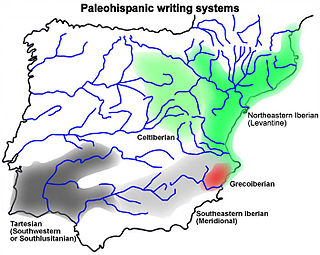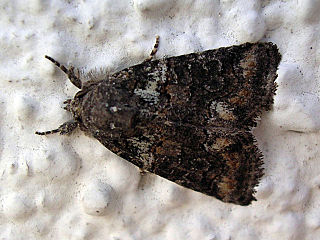
The Iberian Peninsula, also known as Iberia, is a peninsula in South-western Europe, defining the westernmost edge of Eurasia. Separated from the rest of the European landmass by the Pyrenees, it includes the territories of Peninsular Spain and Continental Portugal, comprising most of the region, as well as the tiny adjuncts of Andorra, the British Overseas Territory of Gibraltar, and, pursuant to the traditional definition of the Pyrenees as the peninsula's northeastern boundary, a small part of France. With an area of approximately 583,254 square kilometres (225,196 sq mi), and a population of roughly 53 million, it is the second-largest European peninsula by area, after the Scandinavian Peninsula.

The Tagus is the longest river in the Iberian Peninsula. The river rises in the Montes Universales near Teruel, in mid-eastern Spain, flows 1,007 km (626 mi), generally westward, and empties into the Atlantic Ocean in Lisbon.

The Iberian lynx is one of the four extant species within Lynx, a genus of medium-sized wild cats. The Iberian lynx is endemic to the Iberian Peninsula in southwestern Europe. It is listed as vulnerable on the IUCN Red List. In the 20th century, the Iberian lynx population had declined because of overhunting, poaching, fragmentation of suitable habitats, and the population decline of its main prey species, the European rabbit, caused by myxomatosis and rabbit haemorrhagic disease. Fossils suggest the species has been present in Iberia since the end of the Early Pleistocene, around one million years ago.

The Iberians were an ancient people settled in the eastern and southern coasts of the Iberian peninsula, at least from the 6th century BCE. They are described in Greek and Roman sources. Roman sources also use the term Hispani to refer to the Iberians.
Iberian refers to Iberia. Most commonly Iberian refers to:

The Iberian horse is a designation given to a number of horse breeds native to the Iberian peninsula. At present, some breeds are officially recognized by the FAO, while other horses believed to be native to the peninsula are not. Likewise, some modern breeds are understood from mitochondrial DNA to be descended from historic landraces, while others have origins outside the Iberian peninsula. The remaining FAO-recognized breeds are of well-known foreign blood, or are recently developed breeds.

The Bastetani or Bastuli were an ancient Iberian (pre-Roman) people of the Iberian peninsula. They are believed to have spoken the Iberian language. The relationship between the Iberian Bastetani and the Tartessian Mastieni is not entirely clear.

The Laietani were an ancient Iberian (Pre-Roman) people of the Iberian peninsula. They inhabited the area occupied by the city of Barcelona. One of the main thoroughfares of the city, Via Laietana, is named after the Laietani. They are believed to have spoken an Iberian language.

The Edetani were an ancient Iberian (Pre-Roman) people of the Iberian peninsula. They are believed to have spoken a form of the Iberian language.

Talisker Conservation Park is a protected area in the Australian state of South Australia located on the south-western area of the Fleurieu Peninsula near the town of Cape Jervis and adjacent to Deep Creek Conservation Park. The conservation park covers 211 ha including areas of thick scrub, some steep walking tracks and the heritage-listed remains of a nineteenth century silver and lead mine.

The northeastern Iberian script, also known as Levantine Iberian or Iberian, was the main means of written expression of the Iberian language, but has also been used to write Proto-Basque as seen in the Hand of Irulegi. The Iberian language is also expressed by the southeastern Iberian script and the Greco-Iberian alphabet. To understand the relationship between northeastern Iberian and southeastern Iberian scripts, one should point out that they are two different scripts with different values for the same signs. However, it is clear they have a common origin and the most accepted hypothesis is that northeastern Iberian script was derived from the southeastern Iberian script. Some researchers have concluded that it is linked to the Phoenician alphabet alone, but others believe the Greek alphabet also had a role.

The southeastern Iberian script, also known as Meridional Iberian, was one of the means of written expression of the Iberian language, which was written mainly in the northeastern Iberian script and residually by the Greco-Iberian alphabet. About the relation between northeastern Iberian and southeastern Iberian scripts, it is necessary to point out that they are two different scripts with different values for the same signs; however it is clear that they had a common origin and the most accepted hypothesis is that northeastern Iberian script derives from southeastern Iberian script. In fact, the southeastern Iberian script is very similar, both considering the shape of the signs or their values, to the Southwestern script used to represent an unknown language usually named Tartessian. The main difference is that southeastern Iberian script does not show the vocalic redundancy of the syllabic signs. Unlike the northeastern Iberian script the decipherment of the southeastern Iberian script is not yet complete, because there are a significant number of signs on which scholars have not yet reached a consensus. Although it is believed that the southeastern Iberian script does not show any system to differentiate between voiced and unvoiced occlusives, unlike the northeastern Iberian script, a recent paper defends the existence of a dual system also in the southeastern Iberian script.

Carthaginian Iberia was a province of the larger Carthaginian Empire. The Carthaginians conquered the Mediterranean part of Iberia and remained there until the 2nd Punic war and the Roman conquest of the peninsula.

Hispania was the Roman name for the Iberian Peninsula. Under the Roman Republic, Hispania was divided into two provinces: Hispania Citerior and Hispania Ulterior. During the Principate, Hispania Ulterior was divided into two new provinces, Baetica and Lusitania, while Hispania Citerior was renamed Hispania Tarraconensis. Subsequently, the western part of Tarraconensis was split off, initially as Hispania Nova, which was later renamed "Callaecia". From Diocletian's Tetrarchy onwards, the south of the remainder of Tarraconensis was again split off as Carthaginensis, and all of the mainland Hispanic provinces, along with the Balearic Islands and the North African province of Mauretania Tingitana, were later grouped into a civil diocese headed by a vicarius. The name Hispania was also used in the period of Visigothic rule.

Bryophila is a genus of moths of the family Noctuidae. The genus was described by Treitschke in 1825.

Cryphia is a genus of moths of the family Noctuidae. The genus was erected by Jacob Hübner in 1818.
Ravula, known locally as Yerava or Adiyan, is a Dravidian language of Karnataka and Kerala spoken by the Adiyar. It is classified under the category Malayalam languages in both the linguistics and the Census of India. However their language exhibits a number of peculiarities which marks it off from Malayalam as well as from other tribal speeches in the districts of Kodagu and Wayanad. It is spoken by 25,000 Ravulas in Kodagu district of Karnataka and by 1,900 Ravulas in the adjacent Wayanad district of Kerala. The term 'Yerava' is derived from the Kannada word Yeravalu meaning borrow.
Pterostylis bryophila, commonly known as the Hindmarsh Valley greenhood, is a species of orchid endemic to South Australia. As with similar greenhoods, plants in flower differ from those that are not. In this species, plants not in flower have a rosette of leaves lying flat on the ground, but those in flower have a single small, shiny, bright green and white flower with a protruding, platform-like sinus between the lateral sepals.

Cryphia fraudatricula is a species of moth belonging to the family Noctuidae.













